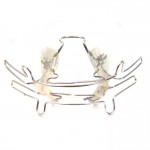
The Class II malocclusion is common and the efficacy of functional orthopaedic treatments to manage the condition is the subject of much debate. The aim of this review is to assess the quality of systematic reviews and meta-analyses on functional orthopaedic treatment of Class II malocclusion and to summarise and rate the reported effects.
Methods
Searches were conducted in the Medline, LILACS, SciELO and Cochrane Library databases without language restriction. Hand searches of the journals (European Journal of Orthodontics, American Journal of Orthodontics and Dentofacial Orthopedics and The Angle Orthodontist) were also undertaken along with searches of the conference abstracts of scientific congresses (European Orthodontic Society and International Association of Dental Research). Systematic review or meta-analyses on the effects of functional orthopaedic appliances on Class II skeletal malocclusion were considered. Two reviewers independently selected studies, abstracted data and assessed study quality. Quality was assessed using the AMSTAR (Assessment of Multiple Systematic Reviews) tool.
Results
- 14 systematic reviews were included
- 5 out of the 14 reviews had carried out a meta-analysis
- The appliances studied included- Activator; Twin Block; headgear; Herbst; Jasper Jumper; Bionator; Fränkel-2
- The mean AMSTER score was 6 (range 2-10)
- 3 reviews were rated as low quality, 8 medium and 3 high quality
- Dento-alveolar effects (3 reviews)
- There is some evidence that functional appliances, considered as a group, significantly decrease overjet (OVJ) with higher results for the Twin Block when assessed individually.
- There is insufficient evidence to support a significant reduction of the OVJ with Splint-Type Herbst appliance
- There is insufficient evidence to determine an effect of the headgear on the OVJ
- There is some evidence of proclination of the lower incisors and retroclination of the upper incisor with Twin Block. There is insufficient evidence for other devices.
- Maxillary skeletal effects (4 reviews)
- There is some evidence of a small maxillary growth restraint with Twin Block appliance and with headgear
- There is some evidence of a non-significant effect with other activators, considered as a group (Harvold, Bionator, Schwarz)
- There is insufficient evidence for other devices
- Mandibular skeletal effects (7 reviews)
- Some evidence of a significant advancement of mandibular position in relation to cranial base was found with Twin Block appliance while some evidence of a very small increase of the same angle was reported with other activators, considered as a group [Harvold, Bionator, Schwarz).
- Soft tissue effects (4 reviews)
- There was insufficient evidence for soft tissue effects
Conclusions
The authors concluded:
There was some evidence of reduction of the overjet, with different appliances except from headgear; there was some evidence of small maxillary growth restrain with Twin Block and headgear; there was some evidence of elongation of mandibular length, but the clinical relevance of this results is still questionable; there was insufficient evidence to determine an effect on soft tissues.
Comments
This review has provided an overview of existing reviews for the early orthodontic management of Class II malocclusions. Only 3 of the included reviews restricted their inclusion criteria to randomised controlled trials and the review with the highest AMSTAR score was a Cochrane review (Dental Elf 7th Jan 2014). While the AMSTAR tool is widely used to assess quality, there are concerns regarding its use as not all elements of the score have the same impact on quality as discussed by the review authors. What is clear from this review of reviews is that the Cochrane review is the most methodologically sound review on this topic to date, but that the quality of available evidence is low. These findings are similar to a recent review by Sunnak et al (Dental Elf 23rd March 2015) that focused on early orthodontic treatment.
Links
D’Antò, V., Bucci, R., Franchi, L., Rongo, R., Michelotti, A. and Martina, R. (2015), Class II functional orthopaedic treatment: a systematic review of systematic reviews. Journal of Oral Rehabilitation. doi: 10.1111/joor.12295
Dental Elf – 23rd March 2015 – Interceptive orthodontics: limited evidence available

Don’t miss – Class II malocclusion: an overview of reviews http://t.co/baoMtqFUi2 #EBP